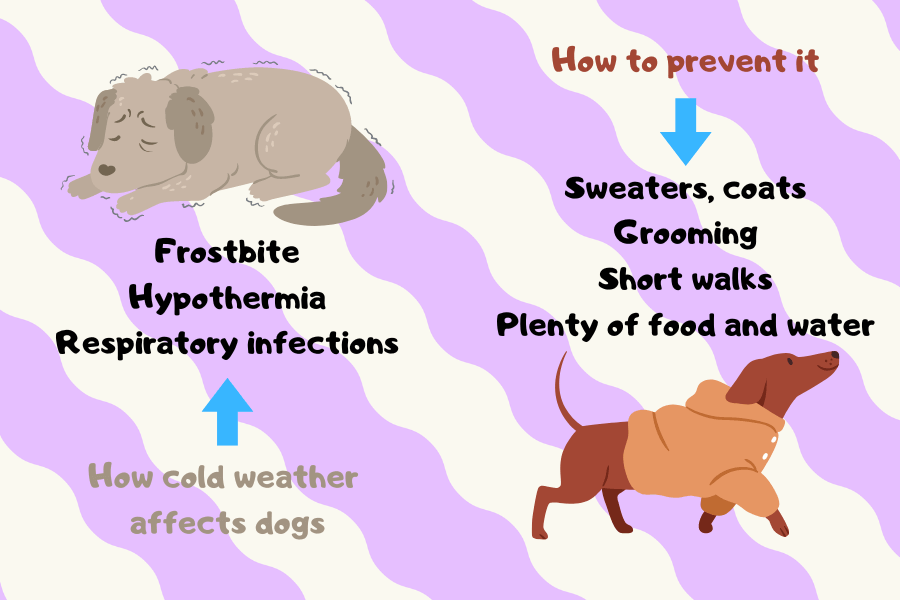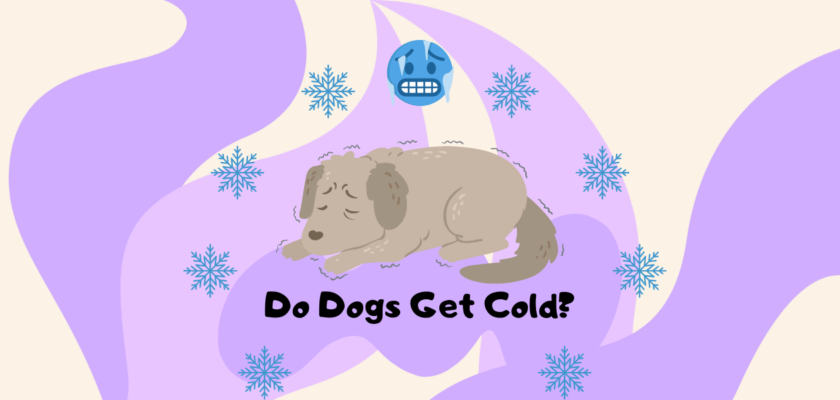Key Takeaways
- Yes, dogs do get cold 🥶
- Dogs are smaller than people, and their fur may not be enough to protect them from cold weather 🐕
- Their size, coat thickness, muzzle shape and body fat determine how well they can withstand the cold 🐕
- To tell if your dog is feeling too chilly, look out for shivering or whining and check their ears’ and nose’s temperature 🌡️
- If you suspect your dog has caught a cold, seek immediate medical attention 👨⚕️
Do Dogs Get Cold? It Depends on the Dog’s Characteristics
Dogs have a different tolerance for cold weather than humans do. They have a higher ratio of surface area to volume than humans, meaning they lose heat more quickly. For this reason, their fur has to provide more insulation than human hair does. Some dogs also tend to play and run more in cold weather in order to warm up. How much do dogs get cold? The extent to which they do depends on a few factors.

Size
Small dogs can feel the cold even more than large dogs do, and they may need a sweater or coat if it’s cold outside. It’s because their tiny bodies lose heat quickly and can’t keep up with generating more. Large dogs have powerful muscles and higher body volume, so they do better in low temperatures.
Coat
The first is their coat. A dog with a thick, fluffy coat will be better able to withstand colder temperatures than a dog with a thin coat. The breeds that are especially sensitive to cold temperatures include dogs with short hair, like the Boston Terrier, and dogs with thin fur, like the Dachshund. On the other hand, dog breeds like Huskies, Alaskan Malamutes, Samoyeds and other northern breeds thrive in the winter.
Muzzle Shape
Bulldogs, boxers and other breeds with pushed-in faces are also at risk, since they have a harder time regulating their body temperature and may be more susceptible to developing respiratory problems than other dogs. That affects their tolerance against both cold and hot weathers. The American Kennel Club recommends that people who have dogs with pushed-in faces avoid taking them out for long walks during the summer months, as well as in the winter.
Body Fat
The second factor is body fat. A leaner dog will feel the cold more than a dog who is carrying a little extra weight. How does this work? Body fat traps heat close to the skin, helping to keep the dog warm by preventing the heat from escaping. Plus, the thicker layer of body fat also helps to insulate them from the cold ground or air, which can help to keep their core temperature warm.
Activity Level
The third factor is activity level. A dog who is constantly running around will generate more body heat than a dog who is mostly inactive. This is because when people or animals move their muscles, they produce heat as a by-product of their natural chemical reactions.
Physical activity also helps to improve blood circulation. The increased blood flow circulates more warm blood throughout the body, which helps to keep it warm. Additionally, physical activity can help to increase the overall number of brown fat cells in the body. Brown fat cells are a special type of fat that helps to generate heat, as well as burn calories – so remember to feed your dog especially well in cold months!
How to Tell If Your Dog Is Cold?
You can tell if your dog is cold by their behavior. If they’re shivering, whining, or seem to be uncomfortable, they may be cold. You can also check their ears and nose. If they’re cold to the touch, your dog is probably feeling cold as well. Also, look out for signs of hypothermia such as lethargy or rapid breathing.
Editor’s Note 🪶
To keep your dog warm on their daily walks, consider investing in a winter coat or sweater designed for dogs. This can help to stave off the cold. Make sure you measure your pet’s size accurately so that the clothing fits properly and doesn’t interfere with their movement. You can also take your dog on shorter walks more often.
How Do Cold Temperatures Affect Dogs?
There are a few ways that cold weather can affect dogs. The most common is dehydration. Dogs can lose a lot of water in the winter, especially if they’re playing outside or running around in dry air. Another way cold can affect dogs is by making them sick. Dogs can get frostbite on their ears, nose, and paws if they’re outside in the cold for too long. They can also get a respiratory infection from exposure to the cold air.

Do dogs get cold to a dangerous extent? In severe cases, when a dog’s body temperature falls below normal, they develop hypothermia. Symptoms of hypothermia in dogs include shivering, weakness, poor coordination, slowed heart rate, and rapid breathing. If left untreated, hypothermia can lead to death.
How to Keep Your Dog Warm?
If you think your dog may be cold, there are a few things you can do to help them out. First, make sure they have a warm place to sleep, away from drafts. You can also put a blanket or coat on them when they’re outside.
- Make sure they have plenty of fresh water to drink.
- Keep your pup’s coat clean and brushed. This will help insulate them from the cold.
- Limit their time outside in the cold. If they’re going to be outside for a long period of time, make sure they have a warm place to go inside.
- Give them plenty of fresh water to drink, and don’t let them eat snow. Snow can contain bacteria that can make them sick.
- Keep an eye on their skin and extremities for signs of frostbite or hypothermia.
- If the dog is wet, it’s important to dry them off and get them warm as soon as possible. Some vets may also recommend warm intravenous fluids. In severe cases, the dog may need to be hospitalized and given warm air or a heating pad to help them get back to normal body temperature.
By following these simple tips, you can help your dog enjoy the winter weather without risking their health! Remember, do dogs get cold? Yes, they do.
What to Do If Your Dog Catches a Cold?
One of the most common ways that dogs catch colds is through exposure to other dogs who are carriers of the virus, as opposed to cold weather. However, a lowered body temperature can weaken your dog’s immunity, making them more susceptible to disease. Symptoms of a dog cold can include:
- sneezing;
- coughing;
- watery, red or swollen eyes;
- a nose that is wetter than usual or covered in mucus.
You can also listen to your dog’s chest to see if it sounds congested, and check for a fever. Remember that the normal body temperature for dogs is 101–102 degrees Fahrenheit. If you think your dog might have a cold, take him to the vet for diagnosis and treatment. You may also need to take some extra steps to help them get better. Here are a few things you can do:
- Make sure your dog has plenty of water and food.
- Keep your pup in a warm, dry environment.
- Help your dog breathe easier by providing them with a humidifier or steamy shower.
- Make sure your dog gets plenty of rest.
- Get immediate veterinary help if their condition worsens.
Do Dogs Get Cold? Let’s Sum Up
Ultimately, do dogs get cold? Yes, they do. How easily they will feel cold depends on many factors, such as their coat, muzzle shape, and physical activity. But with a little extra care, you can keep your dog warm and healthy during the winter months. Thanks for reading!
Frequently Asked Questions
How Cold Is Too Cold for a Dog?
Most dogs will start feeling uncomfortable when the temperatures drop below 45°F. Some breeds are more tolerant of cold weather than others. For example, small dogs (or those with thin coats) may become sick when exposed to temperatures under 32°F for a long time. Frostbite and hypothermia may occur if it’s below 20°F outside.
Do Dogs Need Blankets?
Blankets can be helpful in keeping your dog warm during cold weather. It’s important to make sure the blanket isn’t too thick or heavy, as this can cause them to overheat. Additionally, blankets should only be used when necessary, since they trap moisture and dirt. If you do use a blanket, make sure it’s easy to clean and provide plenty of ventilation.
Do Dogs Get Cold at Night?
With the right care, most dogs will be comfortable in cool weather. However, you may need to provide extra protection during nighttime, when temperatures are usually lowest. If your dog is particularly small or has thin fur, consider providing them with an additional layer of warmth such as a sweaters or blankets – even indoors. Additionally, make sure they have a warm and cozy spot to sleep, such as a dog bed with a cushion or blanket.
Is 40 Degrees Cold for a Dog?
40 degrees Fahrenheit should be a tolerable temperature for most healthy adult dogs. However, puppies and seniors may need extra protection when temperatures drop below this point. If you’re unsure if your dog needs extra warmth or protection in cold weather, check with your veterinarian. They can advise on the best course of action for keeping your four-legged friend warm.
Similar Posts:
- Do Cats Get Cold? How To Keep a Cat Warm In Winter
- Do Cats Sweat? How Can You Keep Your Feline Friend Cool in Summer to Avoid Overheating?
- How to Tell If a Dog Has Fever? High Fever in Dogs
- Do Dogs Sweat Like Humans? How Can They Stay Cool on a Hot Day?
- The Long Haired Chihuahua: A Unique Breed of Dog With a Long Coat
- Why Is My Dog Nose Dry? Find Out the Reasons
- Why Is My Dog Panting So Much? Abnormal Panting in Dogs, When to See a Vet
- Sphynx Cat: A Unique Hairless Cat Breed

